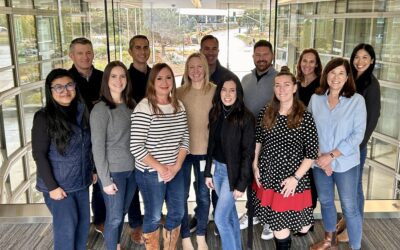Embracing the People Side of Innovation
I’ve been thinking a lot about the people side of innovation lately.
Organizational innovation is usually tied to what we deliver (our ideas and products) or how we do it (the process of designing and creating that product). Who is innovating tends to get lost in the shuffle as an assumed part of innovation. There’s so much focus on idea generation and capture, design thinking methods, and lean startup talk, it’s easy to lose sight that behind EVERY innovation is people! It begs the question: What’s the people side of innovation and how do we empower people to innovate?
Seth Godin captures this by saying, “No organization ever created an innovation. People innovate, not companies.” I think it’s time for departments and groups within organizations—HR, L&D, and Change Management—to own their role in the innovation system… where people, not products or processes, are the focus.
Owning the people side of innovation can seem daunting. Innovation is change AND learning. It requires trust AND momentum. Balancing all those demands can be tough.
So is thinking through big ideas on your own. That’s why I reached out to some of TiER1’s brightest to get their perspective on how leaders can foster organizational innovation and growth. Warning: Some of their insights may surprise you!

How should organizations start on the journey toward being innovative?
Jerry Hamburg: It begins with individuals who look at the world in a way that is improvable and necessary. “Am I looking at the world through a frame of possibility?” Organizations need a clear view of how they create and capture value: an unfiltered, unvarnished look at what they’re trying to do and who they’re trying to serve.
Amy Fox: Oftentimes, L&D and HR operate in their own silo, so their filter and how they look at things is from that mindset. What’s critical is moving beyond just being innovative. In so many ways, just being successful in your role in those areas is about being able to think like the business.
Talk about being successful. What should success look like for organizations that want to innovate?
AF: It’s about L&D, HR, change departments, those groups, being extremely business savvy and really leading with the mindset or the frame of how the business relates to success and numbers, and really being able to think and act like they’re internal clients.
Danny Hoyt: You gotta define success. Everybody asks me, “How are we gonna show success? What are the methods?” Unfortunately, when we think of the notion of success, we automatically subconsciously harken back to what the normative definition of Western success is—the acquisition of or access to capital of all kinds, with monetary and power (be it political or the number of people working for you) capital being the most desirable. That’s the default definition of success.
If you reframe the notion of continual transformation and improvement and ongoing development as core components to the company’s success and growth in ROI, then it’s a really short step to tying ROI to learning and innovation. Because you’re spending less on recruiting and buying on the open market, you’re able to show a more efficient developing workforce, and you’re able to promote the idea of change and innovation tied to real work projects.
OK, so I’ve got the right mindset or frame for innovation and I’ve defined success for my organization. What’s next?
JH: It’s hard work keeping an open and curious mind. But the really hard work comes when we step into that frame toward possibility. Most people are comfortable keeping small frames that serve their worldview, and even more people are comfortable staying on this side of the frame, that side that is known and safe. But organizational innovation requires two actions: opening the frame and walking through it. Mindset and leadership. And leadership is activated by courage. The courage to believe you can make a difference.
The only measure of leadership that matters is followership. I think followership takes nearly as much courage as leadership, especially when things go sideways or upside down (which they always do when we try new things). It requires an act of submission, a willingness to say, “I am going to follow.” There’s where trust comes in.
What role does trust play in an organization wanting to become more innovative?
DH: It’s huge. At times, there’s a real disconnect between the C-suite and their direct reports telling them everything’s rosy, and then what’s happening in the trenches.
AF: Trust is important, because there’s a degree of risk—and it’s calculated risk, usually, that the upside is greater than that risk. When you’re making decisions and really moving forward on any innovative initiative, the trust needs to be there because there’s so much uncertainty. You gotta rely on relationships where you can be completely transparent. There’s more risk when you have a new relationship and that trust is uncertain, because, like in any relationship, you’re figuring out the nuances of how you work together. So, if you go into a situation and you have trust, it just really accelerates that process. I think it reduces some of that risk.
JH: Trust is a big, bold thing, and there’s two sides of it: Trust in myself and trust in somebody else, especially when somebody’s got an innovative idea and I want to be a follower. Trust is the central prerequisite for followership. Without trust, there’s not true followership. On the side of the person who is the leader, there is trust in themselves. There’s trust in their thinking. They have risen to a level in their development where they believe in themselves. That’s the two places trust exerts the most force.
How can organizations foster trust to empower innovation?
DH: It’s not even that executives have to “walk the walk”; they’ve got to communicate in a motivated and sincere way on a regular basis why their people are important to them and what is important for their organization, so that people start knowing that this is an ongoing innovation company that says, “You are in the process of becoming, as we all are.”
AF: When you’re building a relationship and you want to establish trust, you have to have a really open mind, and that’s sometimes hard to do. It takes time, and you’ve got to be OK with just putting yourself out there a bit. There’s a willingness to really want to listen, and really that is so much easier said than done: Be an active, dedicated listener. That is such a missed opportunity in everyone’s work world. To truly put the phone away, look me in the eye, really feel like you have 100 percent of the attention, and just ask good questions.
It’s so oversimplified and so not a common practice in our fast-paced work worlds, but I think that is just kind of ground zero of really trying to establish trust. When someone does that, the impact is that they care. If I think about the people that I’ve started to really trust, in every situation, they’ve really wanted to hear and wanted to be a good listener. I feel like everybody says that, but if everybody could practice that, I think we would have a completely different result.
Owning the people side of innovation.
Talking with Amy, Danny, and Jerry taught me so much and reinforced a few things for me that I’d like to capture. If you’re ready to embrace your role in helping the people in your organization innovate:
Start with trust. Few companies realize how much their culture impacts their ability to innovate. A lack of trust can get in the way of break-through thinking, risk-taking, and radical collaboration. When we trust, we share openly, create connections, and explore new possibilities together.
Redefine success. There’s something cultural about having things perfect. Be relentless in your pursuit of the journey. Help your people value the process of learning and becoming the better version of themselves. When people understand that failure is expected, they’re likely to try things that will surprise and delight.
Widen your frame. When we silo our thinking and goals, we limit our potential and our people. Organizational innovation is intrinsically linked to learning, technology, and change. Function is fiction! Imagine what might happen if you shed your title to furiously focus on the needs of your business and your people. What new possibilities exist?
Step through the frame. I can’t help but think of Steve Jobs’ famous quote: “Innovation distinguishes between a leader and a follower.” It takes courage to shed a title, do something that might step on toes, or make you feel vulnerable… that’s why few do it. This is your opportunity to distinguish yourself and be a leader. There’s also an opportunity for all of us to be better followers of those leaders who take the first step.
Are you ready to own the people side of innovation and empower your people to innovate? Let’s talk! Give us a call at (859) 415-1000 or drop us a line in the form at the bottom of this page.




